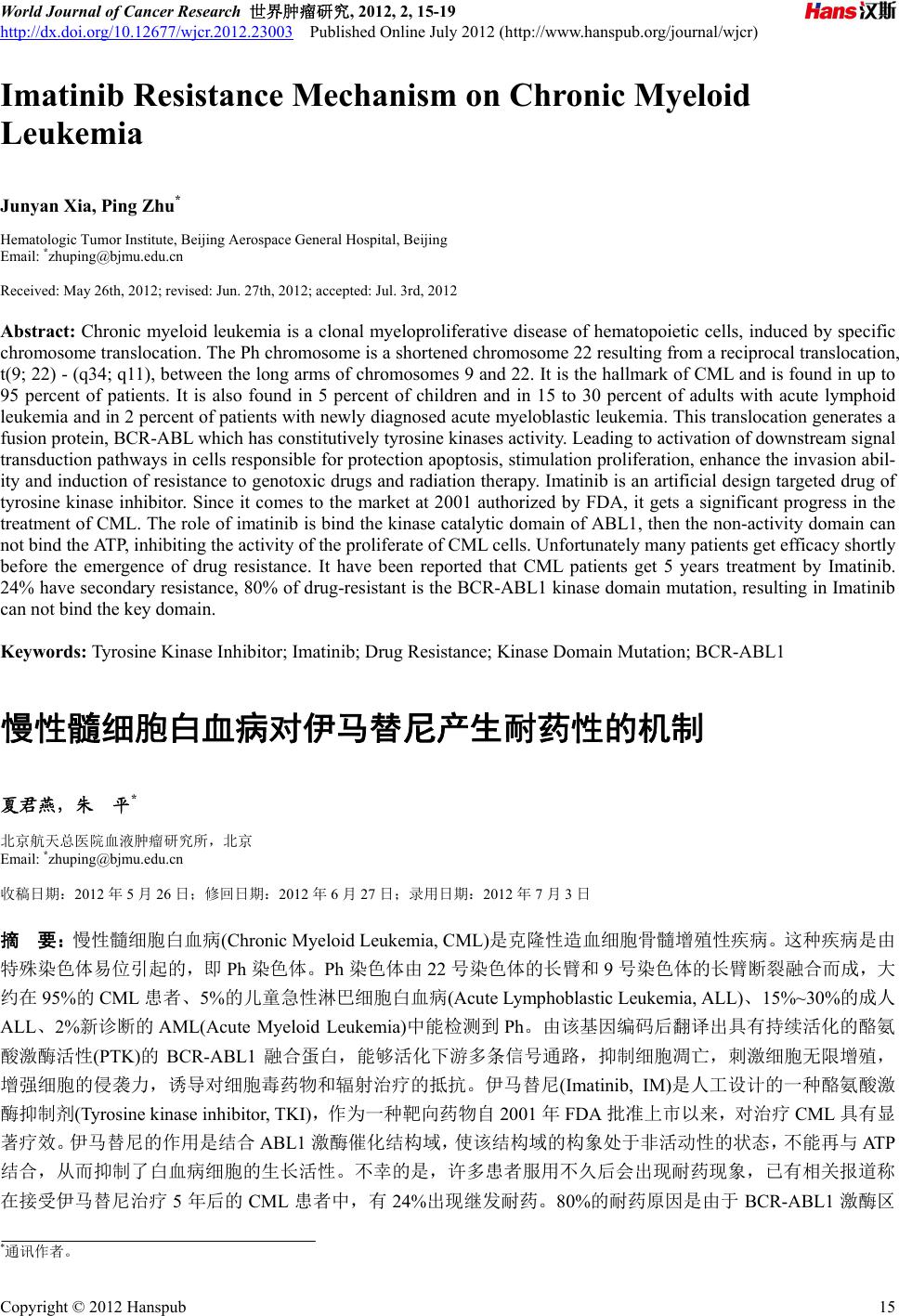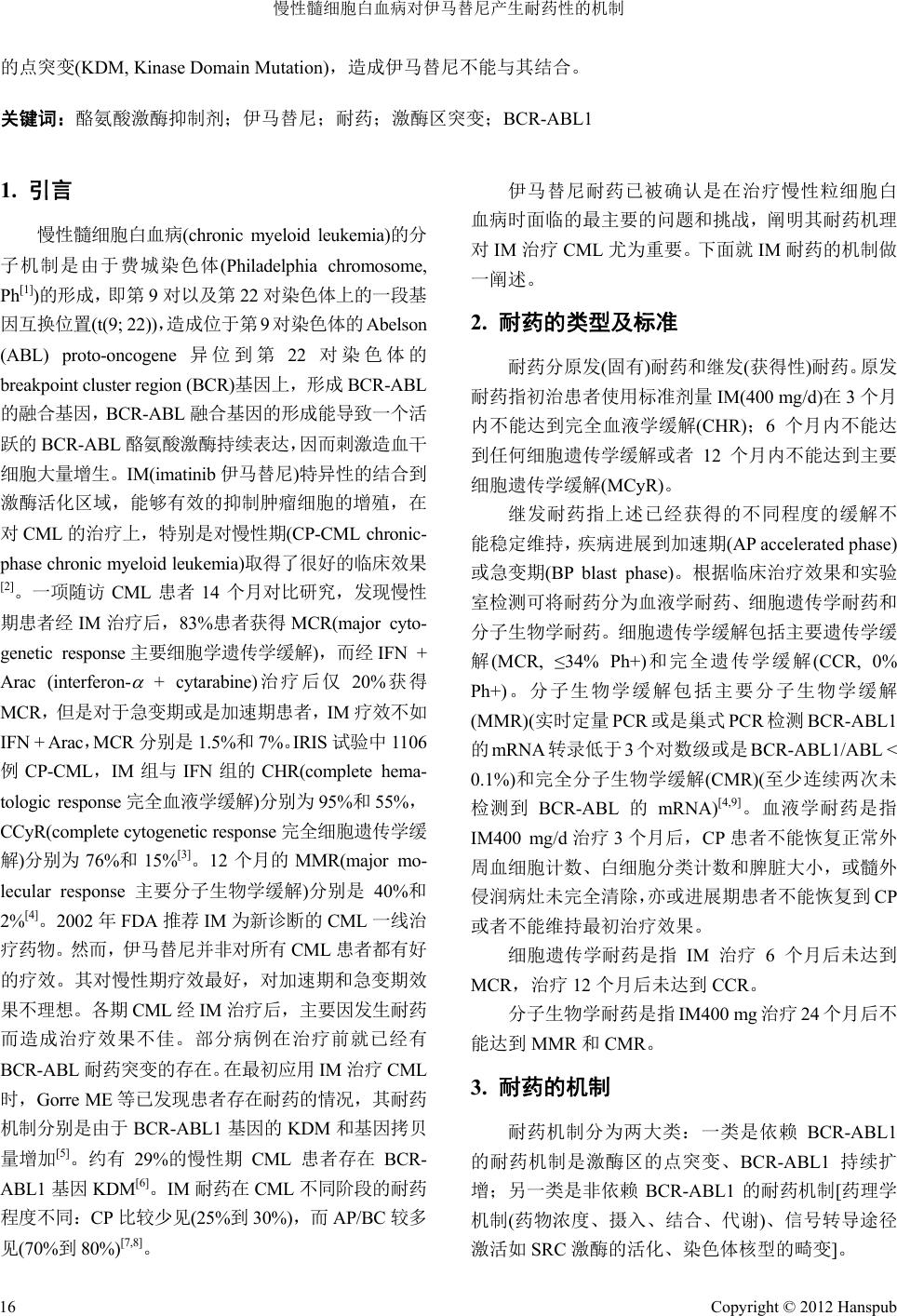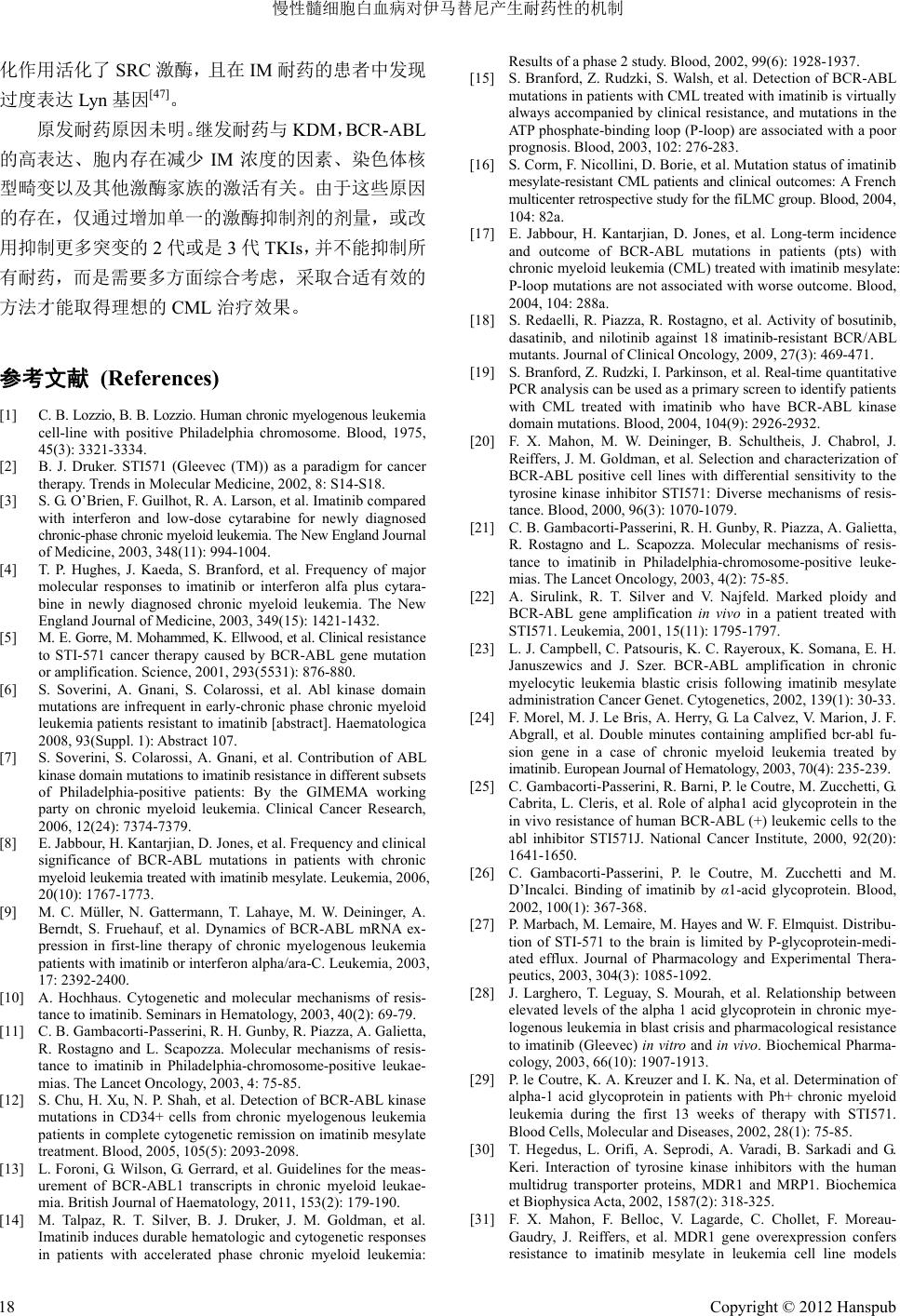 World Journal of Cancer Research 世界肿瘤研究, 2012, 2, 15-19 http://dx.doi.org/10.12677/wjcr.2012.23003 Published Online July 2012 (http://www.hanspub.org/journal/wjcr) Imatinib Resistance Mechanism on Chronic Myeloid Leukemia Junyan Xia, Ping Zhu* Hematologic Tumor Institute, Beijing Aerospace General Hospital, Beijing Email: *zhuping@bjmu.edu.cn Received: May 26th, 2012; revised: Jun. 27th, 2012; accepted: Jul. 3rd, 2012 Abstract: Chronic myeloid leukemia is a clonal myeloproliferative disease of hematopoietic cells, induced by specific chromosome translocation. The Ph chromosome is a shortened chromosome 22 resulting from a reciprocal translocation, t(9; 22) - (q34; q11), between the long arms of chromosomes 9 and 22. It is the hallmark of CML and is found in up to 95 percent of patients. It is also found in 5 percent of children and in 15 to 30 percent of adults with acute lymphoid leukemia and in 2 percent of patients with newly diagnosed acute myeloblastic leukemia. This translocation generates a fusion protein, BCR-ABL which has constitutively tyrosine kinases activity. Leading to activation of downstream signal transduction pathways in cells responsible for protection apoptosis, stimulation proliferation, enhance the invasion abil- ity and induction of resistance to genotoxic drugs and radiation therapy. Imatinib is an artificial design targeted drug of tyrosine kinase inhibitor. Since it comes to the market at 2001 authorized by FDA, it gets a significant progress in the treatment of CML. The role of imatinib is bind the kinase catalytic domain of ABL1, then the non-activity domain can not bind the ATP, inhibiting the activity of the proliferate of CML cells. Unfortunately many patients get efficacy shortly before the emergence of drug resistance. It have been reported that CML patients get 5 years treatment by Imatinib. 24% have secondary resistance, 80% of drug-resistant is the BCR-ABL1 kinase domain mutation, resulting in Imatinib can not bind the key domain. Keywords: Tyrosine Kinase Inhibitor; Imatinib; Drug Resistance; Kinase Domain Mutation; BCR-ABL1 慢性髓细胞白血病对伊马替尼产生耐药性的机制 夏君燕,朱 平* 北京航天总医院血液肿瘤研究所,北京 Email: *zhuping@bjmu.edu.cn 收稿日期:2012 年5月26 日;修回日期:2012年6月27 日;录用日期:2012 年7月3日 摘 要:慢性髓细胞白血病(Chronic Myeloid Leukemia, CML)是克隆性造血细胞骨髓增殖性疾病。这种疾病是由 特殊染色体易位引起的,即Ph 染色体。Ph 染色体由 22 号染色体的长臂和 9号染色体的长臂断裂融合而成,大 约在 95%的CML 患者、5%的儿童急性淋巴细胞白血病(Acute Lymphoblastic Leukemia, ALL)、15%~30%的成人 ALL、2%新诊断的 AML(Acute Myeloid Leukemia)中能检测到 Ph。由该基因编码后翻译出具有持续活化的酪氨 酸激酶活性(PTK)的BCR-ABL1 融合蛋白,能够活化下游多条信号通路,抑制细胞凋亡,刺激细胞无限增殖, 增强细胞的侵袭力,诱导对细胞毒药物和辐射治疗的抵抗。伊马替尼(Imatinib, IM)是人工设计的一种酪氨酸激 酶抑制剂(Tyrosine kinase inhibitor, TKI),作为一种靶向药物自 2001 年FDA批准上市以来,对治疗 CML具有显 著疗效。伊马替尼的作用是结合 ABL1激酶催化结构域,使该结构域的构象处于非活动性的状态,不能再与ATP 结合,从而抑制了白血病细胞的生长活性。不幸的是,许多患者服用不久后会出现耐药现象,已有相关报道称 在接受伊马替尼治疗 5年后的 CML 患者中,有 24%出现继发耐药。80%的耐药原因是由于 BCR-ABL1 激酶区 *通讯作者。 Copyright © 2012 Hanspub 15  慢性髓细胞白血病对伊马替尼产生耐药性的机制 Copyright © 2012 Hanspub 16 的点突变(KDM, Kinase Domain Mutation),造成伊马替尼不能与其结合。 关键词:酪氨酸激酶抑制剂;伊马替尼;耐药;激酶区突变;BCR-ABL1 1. 引言 慢性髓细胞白血病(chronic myeloid leukemia)的分 子机制是由于费城染色体(Philadelphia chromosome, Ph[1])的形成,即第 9对以及第 22 对染色体上的一段基 因互换位置(t(9; 22)),造成位于第 9对染色体的 Abelson (ABL) proto-oncogene 异位到第 22 对染色体的 breakpoint cluster region (BCR)基因上,形成 BCR-ABL 的融合基因,BCR-ABL 融合基因的形成能导致一个活 跃的 BCR-ABL 酪氨酸激酶持续表达,因而刺激造血干 细胞大量增生。IM(imatinib 伊马替尼)特异性的结合到 激酶活化区域,能够有效的抑制肿瘤细胞的增殖,在 对CML 的治疗上,特别是对慢性期(CP-CML chronic- phase chronic myeloid leukemia)取得了很好的临床效果 [2]。一项随访 CML 患者 14 个月对比研究,发现慢性 期患者经 IM 治疗后,83%患者获得 MCR(major cyto- genetic response主要细胞学遗传学缓解),而经 IFN + Arac (interferon- + cytarabine)治疗后仅 20% 获得 MCR,但是对于急变期或是加速期患者,IM疗效不如 IFN + Arac,MCR分别是 1.5%和7%。IRIS试验中1106 例CP-CML,IM 组与IFN 组的 CHR(complete hema- tologic response完全血液学缓解)分别为 95%和55%, CCyR(complete cytogenetic response完全细胞遗传学缓 解)分别为 76%和15%[3]。12 个月的MMR(major mo- lecular response 主要分子生物学缓解)分别是 40%和 2%[4]。2002 年FDA 推荐IM 为新诊断的 CML 一线治 疗药物。然而,伊马替尼并非对所有 CML患者都有好 的疗效。其对慢性期疗效最好,对加速期和急变期效 果不理想。各期 CML 经IM治疗后,主要因发生耐药 而造成治疗效果不佳。部分病例在治疗前就已经有 BCR-ABL 耐药突变的存在。在最初应用 IM 治疗 CML 时,Gorre ME等已发现患者存在耐药的情况,其耐药 机制分别是由于 BCR-ABL1 基因的 KDM 和基因拷贝 量增加[5]。约有 29%的慢性期 CML 患者存在 BCR- ABL1 基因KDM[6]。IM耐药在 CML 不同阶段的耐药 程度不同:CP 比较少见(25%到30%),而 AP/BC 较多 见(70%到80%)[7,8]。 伊马替尼耐药已被确认是在治疗慢性粒细胞白 血病时面临的最主要的问题和挑战,阐明其耐药机理 对IM 治疗CML 尤为重要。下面就IM 耐药的机制做 一阐述。 2. 耐药的类型及标准 耐药分原发(固有)耐药和继发(获得性)耐药。原发 耐药指初治患者使用标准剂量IM(400 mg/d)在3个月 内不能达到完全血液学缓解(CHR);6个月内不能达 到任何细胞遗传学缓解或者 12 个月内不能达到主要 细胞遗传学缓解(MCyR)。 继发耐药指上述已经获得的不同程度的缓解不 能稳定维持,疾病进展到加速期(AP accelerated phase) 或急变期(BP blast phase)。根据临床治疗效果和实验 室检测可将耐药分为血液学耐药、细胞遗传学耐药和 分子生物学耐药。细胞遗传学缓解包括主要遗传学缓 解(MCR, ≤34% Ph+)和完全遗传学缓解(CCR, 0% Ph+)。分子生物学缓解包括主要分子生物学缓解 (MMR)(实时定量 PCR 或是巢式 PCR 检测 BCR-ABL1 的mRNA 转录低于 3个对数级或是 BCR-ABL1/ABL < 0.1%)和完全分子生物学缓解(CMR)(至少 连续两次未 检测到 BCR-ABL 的mRN A) [4,9]。血液学耐药是指 IM400 mg/d治疗3个月后,CP 患者不能恢复正常外 周血细胞计数、白细胞分类计数和脾脏大小,或髓外 侵润病灶未完全清除,亦或进展期患者不能恢复到 CP 或者不能维持最初治疗效果。 细胞遗传学耐药是指IM 治疗 6个月后未达到 MCR,治疗 12 个月后未达到 CCR。 分子生物学耐药是指 IM400 mg治疗24个月后不 能达到 MMR和CMR。 3. 耐药的机制 耐药机制分为两大类:一类是依赖 BCR-ABL1 的耐药机制是激酶区的点突变、BCR-ABL1 持续扩 增;另一类是非依赖 BCR-ABL1 的耐药机制[药理学 机制(药物浓度、摄入、结合、代谢)、信号转导途径 激活如 SRC 激酶的活化、染色体核型的畸变]。  慢性髓细胞白血病对伊马替尼产生耐药性的机制 3.1. KDM (Kinase Domain Mutation,激酶区 的点突变) IM 耐药最常见的原因是 BCR-ABL1 激酶区点突 变(KDM)导致氨基酸的替换,阻止了 IM 与ABL1 激 酶区的结合,或是阻止了活化区域的激活[ 10,11]。早在 2001 年,Gorre ME[5]等人观察到 9例患者中有 3例发 生了 ABL1 酪氨酸激酶结构域的苏氨酸被异亮氨酸替 代(T315I),这种单一的氨基酸替换破坏了ABL1 的激 酶区和 IM 之间形成的氢键,使 IM 不能结合从而促 使BCR-ABL1 基因持续扩增。CP-CML 经IM 治疗后 发生获得性耐药的有 30%~35%[12,13],进展期CML 经 IM 治疗后原发耐药和继发耐药率均增加,可达到 70%~80%[14]。耐药的主要机制是在 BCR-ABL1激酶 区发生点突变,从而影响伊马替尼的结合力。现已发 现100 多种点突变,覆盖了激酶区的全长,包括 P- 环,ATP结合位点,催化区域,A-环,C-helix 及羧基 末端,以 ATP 结合位点的 T315I 突变最多见。不同类 型的突变对 IM 的耐药程度不同。位于 P-环的 Y253H、 E255V、E255K、Y253H及ATP 结合位点的T315I 突 变均导致高度耐药[15]。法国和意大利的研究者[15,16]认 为P环突变预后差,但美国研究者[17]却认为此突变预 后不一定差。 M244V、G250E、Q252H、F317L、E355G、F359V、 V379I、H396R 导致中度耐药[18],以上耐药突变可以通 过增加 IM 的剂量获得缓解。突变的检出率还依赖检测 手段和疾病分期,突变多见于 AP/BC 期。新上市的 2 代或 3代TKI 对绝大部分耐药突变有效,可抑制 100 种以上的突变,但对 T315I 突变仍然无效,而且随 TKIs 的替换使用,新的耐药突变不断出现。除了点突变外, 还有因剪切点的不同导致产物出现某几个外显子缺 失,或外显子之间插入 35 bp 等改变而出现耐药。此外, 体外实验证实 BCR-ABL1 分子随机发生突变,经过 IM 药物的压力,会出现一些耐药的优势突变。因此检测 KDM 的时机就显得尤为重要,所以临床医生需要采用 灵敏的突变检测技术,早期适时调整治疗计划。 3.2. BCR-ABL1的持续扩增 Branford 等[19]通过研究检测到 BCR-ABL1扩增, 转录本增加 2倍以上,97%病例可以检测到突变,并 把这作为耐药突变的一个早期标志。Mahon 等[20]利用 转CML 患者的BCR-ABL 阳性的细胞,建立的鼠和 人的细胞系研究 BCR-ABL1 的扩增与 IM 耐药的关 系。通过增加IM 浓度培养这些细胞发现,耐药的细 胞表达的BCR-ABL1 转录水平是正常细胞的 3~5 倍。 同时在临床上也观察到 IM 耐药患者 BCR-ABL1基因 的高表达[5,21-24] ,也有部分IM 耐药的病人没有 BCR-ABL1 基因扩增,推测可能在基因转录,翻译, 翻译后修饰等过程中存在其他的因素抑制其表达。 3.3. 耐药药理学因素 CML 患者发生耐药,也可能是由于进入体内的 IM 被血浆中的酶修饰。例如,肝脏产 生的 细胞色 素 氧化酶 P450的同工酶 3A4 可对 IM进行修饰,从而 影响其活性。血浆中的 α1-酸性糖蛋白可竞争性结合 IM,从而抑制 IM 的生物学活性[25-29]。肿瘤细胞的耐 药大多和多重耐药基因MDR1 有关,CML 患者的耐 药也可以通过高表达MDR1 而降低 IM 的浓度[30,31]。 MDR1 基因翻译的蛋白为 P-gp,研究发现有 P-gp 高 表达的白血病细胞,其IM 浓度低于正常,这提示着 P-gp 可能将 IM转运至胞外[30,32],通过药物抑制P-gp 可以使患者恢复对 IM 的敏感性[33]。 3.4. 染色体核型演变(克隆的演化)(ACA additional cytogenetic aberrations) 在IM 问世之前,10%~12%的CP-CML 就已经出 现了非典型的染色体核型,但是在诊断时仅有 5%被 发现。进展期出现非典型染色体核型可以达到 80%。 AP 常见的ACA 以8号染色体三体最为多见,以及出 现另一个Ph,17 号染色体等臂 17(q10),Y染色体缺 失,t(v: 22)[34]。ACA 不受 TKI 的抑制[35,36],出现ACA 提示疾病进展,预后不良[37-39]。 ACA 的出现影响 IM 治疗 Ph阳性的白血病所获 得的细胞遗传学缓解[40]。ELN(欧洲白血病网络组织) 认为治疗过程中出现的ACA 为危险因子[41],无论什 么类型的 ACA 都被认为是预后不好的因素[42,43]。 5%~10%病人发现t(v; 22),5%的病人发现 Y染色体 的缺失,但对预后影响不大[44-46]。 3.5. SRC激酶家族(Fyn, Lyn, c-Src)的活化 SRC 激酶介导细胞表面的信号传导,与细胞的迁 移、粘附和生长分化有关。CML 患者 BCR-ABL 磷酸 Copyright © 2012 Hanspub 17  慢性髓细胞白血病对伊马替尼产生耐药性的机制 化作用活化了SRC 激酶,且在 IM 耐药的患者中发现 过度表达Lyn 基因[47]。 原发耐药原因未明。继发耐药与 KDM,BCR-ABL 的高表达、胞内存在减少 IM浓度的因素、染色体核 型畸变以及其他激酶家族的激活有关。由于这些原因 的存在,仅通过增加单一的激酶抑制剂的剂量,或改 用抑制更多突变的 2代或是3代TKIs,并不能抑制所 有耐药,而是需要多方面综合考虑,采取合适有效的 方法才能取得理想的CML 治疗效果。 参考文献 (References) [1] C. B. Lozzio, B. B. Lozzio. Human chronic myelogenous leukemia cell-line with positive Philadelphia chromosome. Blood, 1975, 45(3): 3321-3334. [2] B. J. Druker. STI571 (Gleevec (TM)) as a paradigm for cancer therapy. Trends in Molecular Medicine, 2002, 8: S14-S18. [3] S. G. O’Brien, F. Guilhot, R. A. Larson, et al. Imatinib compared with interferon and low-dose cytarabine for newly diagnosed chronic-phase chronic myeloid leukemia. The New England Journal of Medicine, 2003, 348(11): 994-1004. [4] T. P. Hughes, J. Kaeda, S. Branford, et al. Frequency of major molecular responses to imatinib or interferon alfa plus cytara- bine in newly diagnosed chronic myeloid leukemia. The New England Journal of Medicine, 2003, 349(15): 1421-1432. [5] M. E. Gorre, M. Mohammed, K. Ellwood, et al. Clinical resistance to STI-571 cancer therapy caused by BCR-ABL gene mutation or amplification. Science, 2001, 293(5531): 876-880. [6] S. Soverini, A. Gnani, S. Colarossi, et al. Abl kinase domain mutations are infrequent in early-chronic phase chronic myeloid leukemia patients resistant to imatinib [abstract]. Haematologica 2008, 93(Suppl. 1): Abstract 107. [7] S. Soverini, S. Colarossi, A. Gnani, et al. Contribution of ABL kinase domain mutations to imatinib resistance in different subsets of Philadelphia-positive patients: By the GIMEMA working party on chronic myeloid leukemia. Clinical Cancer Research, 2006, 12(24): 7374-7379. [8] E. Jabbour, H. Kantarjian, D. Jones, et al. Frequency and clinical significance of BCR-ABL mutations in patients with chronic myeloid leukemia treated with imatinib mesylate. Leukemia, 2006, 20(10): 1767-1773. [9] M. C. Müller, N. Gattermann, T. Lahaye, M. W. Deininger, A. Berndt, S. Fruehauf, et al. Dynamics of BCR-ABL mRNA ex- pression in first-line therapy of chronic myelogenous leukemia patients with imatinib or interferon alpha/ara-C. Leukemia, 2003, 17: 2392-2400. [10] A. Hochhaus. Cytogenetic and molecular mechanisms of resis- tance to imatinib. Seminars in Hematology, 2003, 40(2): 69-79. [11] C. B. Gambacorti-Passerini, R. H. Gunby, R. Piazza, A. Galietta, R. Rostagno and L. Scapozza. Molecular mechanisms of resis- tance to imatinib in Philadelphia-chromosome-positive leukae- mias. The Lancet Oncology, 2003, 4: 75-85. [12] S. Chu, H. Xu, N. P. Shah, et al. Detection of BCR-ABL kinase mutations in CD34+ cells from chronic myelogenous leukemia patients in complete cytogenetic remission on imatinib mesylate treatment. Blood, 2005, 105(5): 2093-2098. [13] L. Foroni, G. Wilson, G. Gerrard, et al. Guidelines for the meas- urement of BCR-ABL1 transcripts in chronic myeloid leukae- mia. British Journal of Haematology, 2011, 153(2): 179-190. [14] M. Talpaz, R. T. Silver, B. J. Druker, J. M. Goldman, et al. Imatinib induces durable hematologic and cytogenetic responses in patients with accelerated phase chronic myeloid leukemia: Results of a phase 2 study. Blood, 2002, 99(6): 1928-1937. [15] S. Branford, Z. Rudzki, S. Walsh, et al. Detection of BCR-ABL mutations in patients with CML treated with imatinib is virtually always accompanied by clinical resistance, and mutations in the ATP phosphate-binding loop (P-loop) are associated with a poor prognosis. Blood, 2003, 102: 276-283. [16] S. Corm, F. Nicollini, D. Borie, et al. Mutation status of imatinib mesylate-resistant CML patients and clinical outcomes: A French multicenter retrospective study for the fiLMC group. Blood, 2004, 104: 82a. [17] E. Jabbour, H. Kantarjian, D. Jones, et al. Long-term incidence and outcome of BCR-ABL mutations in patients (pts) with chronic myeloid leukemia (CML) treated with imatinib mesylate: P-loop mutations are not associated with worse outcome. Blood, 2004, 104: 288a. [18] S. Redaelli, R. Piazza, R. Rostagno, et al. Activity of bosutinib, dasatinib, and nilotinib against 18 imatinib-resistant BCR/ABL mutants. Journal of Clinical Oncology, 2009, 27(3): 469-471. [19] S. Branford, Z. Rudzki, I. Parkinson, et al. Real-time quantitative PCR analysis can be used as a primary screen to identify patients with CML treated with imatinib who have BCR-ABL kinase domain mutations. Blood, 2004, 104(9): 2926-2932. [20] F. X. Mahon, M. W. Deininger, B. Schultheis, J. Chabrol, J. Reiffers, J. M. Goldman, et al. Selection and characterization of BCR-ABL positive cell lines with differential sensitivity to the tyrosine kinase inhibitor STI571: Diverse mechanisms of resis- tance. Blood, 2000, 96(3): 1070-1079. [21] C. B. Gambacorti-Passerini, R. H. Gunby, R. Piazza, A. Galietta, R. Rostagno and L. Scapozza. Molecular mechanisms of resis- tance to imatinib in Philadelphia-chromosome-positive leuke- mias. The Lancet Oncology, 2003, 4(2): 75-85. [22] A. Sirulink, R. T. Silver and V. Najfeld. Marked ploidy and BCR-ABL gene amplification in vivo in a patient treated with STI571. Leukemia, 2001, 15(11): 1795-1797. [23] L. J. Campbell, C. Patsouris, K. C. Rayeroux, K. Somana, E. H. Januszewics and J. Szer. BCR-ABL amplification in chronic myelocytic leukemia blastic crisis following imatinib mesylate administration Cancer Genet. Cytogenetics, 2002, 139(1): 30-33. [24] F. Morel, M. J. Le Bris, A. Herry, G. La Calvez, V. Marion, J. F. Abgrall, et al. Double minutes containing amplified bcr-abl fu- sion gene in a case of chronic myeloid leukemia treated by imatinib. European Journal of Hematology, 2003, 70(4): 235-239. [25] C. Gambacorti-Passerini, R. Barni, P. le Coutre, M. Zucchetti, G. Cabrita, L. Cleris, et al. Role of alpha1 acid glycoprotein in the in vivo resistance of human BCR-ABL (+) leukemic cells to the abl inhibitor STI571J. National Cancer Institute, 2000, 92(20): 1641-1650. [26] C. Gambacorti-Passerini, P. le Coutre, M. Zucchetti and M. D’Incalci. Binding of imatinib by α1-acid glycoprotein. Blood, 2002, 100(1): 367-368. [27] P. Marbach, M. Lemaire, M. Hayes and W. F. Elmquist. Distribu- tion of STI-571 to the brain is limited by P-glycoprotein-medi- ated efflux. Journal of Pharmacology and Experimental Thera- peutics, 2003, 304(3): 1085-1092. [28] J. Larghero, T. Leguay, S. Mourah, et al. Relationship between elevated levels of the alpha 1 acid glycoprotein in chronic mye- logenous leukemia in blast crisis and pharmacological resistance to imatinib (Gleevec) in vitro and in vivo. Biochemical Pharma- cology, 2003, 66(10): 1907-1913. [29] P. le Coutre, K. A. Kreuzer and I. K. Na, et al. Determination of alpha-1 acid glycoprotein in patients with Ph+ chronic myeloid leukemia during the first 13 weeks of therapy with STI571. Blood Cells, Molecular and Diseases, 2002, 28(1): 75-85. [30] T. Hegedus, L. Orifi, A. Seprodi, A. Varadi, B. Sarkadi and G. Keri. Interaction of tyrosine kinase inhibitors with the human multidrug transporter proteins, MDR1 and MRP1. Biochemica et Biophysica Acta, 2002, 1587(2): 318-325. [31] F. X. Mahon, F. Belloc, V. Lagarde, C. Chollet, F. Moreau- Gaudry, J. Reiffers, et al. MDR1 gene overexpression confers resistance to imatinib mesylate in leukemia cell line models Copyright © 2012 Hanspub 18  慢性髓细胞白血病对伊马替尼产生耐药性的机制 Copyright © 2012 Hanspub 19 Blood, 2003, 101(6): 2368-2373. [32] J. Thomas, L. Wang, R. E. Clark and M. Pirmohamed. Active transport of imatinib into and out of cells: Implications for drug resistance. Blood, 2004, 104(12): 3739-3745. [33] H. Rumpold, A. M. Wolf, K. Gruenewald, et al. RNAi-mediated knockdown of P-glycoprotein using a transposon-based vector system durably restores imatinib sensitivity in imatinib-resistant CML cell lines. Experimental Hematology, 2005, 33(7): 767-775. [34] F. Mitelman, G. Levan, P. G. Nilsson and L. Brandt. Non-random karyotypic evolution in chronic myeloid leukemia. International Journal of Cancer, 1976, 18(1): 24-30. [35] C. Schoch, T. Haferlach, W. Kern, et al. Occurrence of addi- tional chromosome aberrations in chronic myeloid leukemia pa- tients treated with imatinib mesylate. Leukemia, 2003, 17(2): 461- 463. [36] D. Verma, H. Kantarjian, J. Shan, et al. Survival outcomes for clonal evolution in chronic myeloid leukemia patients on second generation tyrosine kinase inhibitor therapy. Cancer, 2010, 116(11): 2673-2681. [37] J. E. Cortes, M. Talpaz, F. Giles, et al. Prognostic significance of cytogenetic clonal evolution in patients with chronic myeloge- nous leukemia on imatinib mesylate therapy. Blood, 2003, 101(10): 3794-3800. [38] M. E. O’Dwyer, M. J. Mauro, G. Kurilik, et al The impact of clonal evolution on response to imatinib mesylate (STI571) in accelerated phase CML. Blood, 2002, 100(5): 1628-1633. [39] M. E. O’Dwyer, M. J. Mauro, C. Blasdel, et al. Clonal evolution and lack of cytogenetic response are adverse prognostic factors for hematologic relapse of chronic phase CML patients treated with imatinib mesylate. Blood, 2004, 103(2): 451-455. [40] C. Schoch, T. Haferlach, W. Kern, et al. Occurrence of addi- tional chromosome aberrations in chronic myeloid leukemia pa- tients treated with imatinib mesylate. Leukemia, 2003, 17(2): 461-463. [41] M. Baccarani, J. Cortes, F. Pane, et al. Chronic myeloid leuke- mia: An update of concepts and management recommendations of European Leukemia. Journal of Clinical Oncology, 2009, 27(35): 6041-6051. [42] H. Kantarjian, T. Smith, K. McCredie, et al. Chronic myeloge- nous leukemia: A multivariate analysis of the associations of pa- tient characteristics and therapy with survival. Blood, 1985, 66(6): 1326-1335. [43] H. M. Kantarjian, M. J. Keating, et al. Proposal for a simple synthesis prognostic staging system in chronic myelogenous leukemia. American Journal of Medicine, 1990, 88(1): 1-8. [44] F. Mitelman. The cytogenetic scenario of chronic myeloid leu- kemia. Leuk Lymphoma, 1993, 11(s1): 11-15. [45] F. Albano, G. Specchia, L. Anelli, et al. Genomic deletions on other chromosomes involved in variant t(9, 22) chronic myeloid leukemia cases. Genes Chromosomes Cancer, 2003, 36(4): 353- 360. [46] M. M. T. El-Zimaity, H. Kantarjian, M. Talpaz, et al. Results of imatinib mesylate therapy in chronic myelogenous leukaemia with variant Philadelphia chromosome. British Journal of Hae- matology, 2004, 125(2): 187-195. [47] J. Nicholas, D. Ji, Y. Wu, et al. BCR-ABL independence and LYN kinase overexpression in chronic myelogenous leukemia cells selected for resistance to STI571. Blood, 2003, 101(2): 690- 698. |